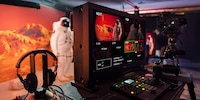
Background information
RGB Mini LED: Sony vs. Hisense – precision instead of overwhelming brightness
by Luca Fontana

It’s Sony against the rest of the world. While Samsung, LG, TCL and Hisense are chasing market share, Sony has decided on a different path to success. I spoke to Sony TV boss Shoji Charlie Ohama about strategies, competition and the main trends in the industry right now.
A few days ago, Sony gave selected journalists in London a sneak peek of the next display technology poised to shake up the high-end TV segment: RGB LED. It’s a new approach that’ll supposedly deliver even more precise colour gradations and more brightness. But the competition never sleeps.
While Samsung and LG are continuing to focus on Mini LEDs and OLEDs, TCL and Hisense are rolling up the field with aggressively low prices. Sony, on the other hand, is pursuing its own course: less market share, better picture quality. But how long will this strategy continue to work? And what actually makes RGB LED better than other technologies?
I had the opportunity to go to London to talk about all this with Shoji Charlie Ohama, Head of TV, Home Audio + Video for Europe. However, RGB LED wasn’t the only discussion point on the table. We also spoke about Sony’s shaky position in a highly competitive market, the uncertain future of Micro LED, the question of whether 8K is ultimately just an expensive marketing gimmick, and why Sony’s convinced that quality will ultimately win out over quantity, despite growing competition.

Charlie, let’s address the elephant in the room. Sony was once a TV superpower. Today, you’re only number five in the world. Was that a deliberate strategy? To sort of cleverly retreat into the premium segment? Or did Samsung, LG, TCL and Hisense simply overtake you?
Ha! Good question. Sony has built up a strong position in the TV business over the past fifty years, but we don’t view the TV market as a single entity. We leave that to the media.
How do you view it then?
The TV market is huge and extremely diverse. On the one hand, you have tiny, affordable 19- or 22-inch models. On the other, you have gigantic 115-inch premium TVs. If market share were our only concern, we could just focus on mass production and churn out cheap, entry-level TVs. Our sales figures would look completely different that way.
So that’s not what you want?
No, our focus has always been on the mid to upper price segment. Obviously that won’t make us as big as Samsung or LG, and it certainly won’t make our pricing as aggressive as TCL’s or Hisense’s. But high-end TVs are the very area we’re really strong in.
«A panel alone doesn’t make a great picture – it’s the processor performance that counts.»
I see. You’re prioritising profitability over mass production.
Yes and no. Of course, as a business, we have to be profitable. But it’s not about achieving the highest possible margins – it’s about giving our customers the best possible picture quality for their money. That’s what we aspire to.
Samsung dominates when it comes to mass-market products. LG’s the big player in the Mini LED sector. At the same time, TCL and Hisense are pushing into the market with aggressive prices. What about Sony? What makes your TVs unique?
I’d say our unique selling point is that we don’t rely on one single display technology. LG is going full OLED, while others are pushing Mini LED or QD-OLED. We, on the other hand, are using everything from OLEDs and QD-OLEDs to Mini LEDs and traditional LEDs. Here’s the crucial thing: our strength isn’t panels, it’s image processing.
Could you expand on that?
For years now, our focus has been on perfect image optimisation. These days, everyone’s calling their processors «AI-powered», but we’ve been working with advanced algorithms for ages. The reason Sony TVs are constantly winning awards is that we deliver the most natural, most accurate picture, straight out of the box. It’s not because we have the brightest or biggest displays.
Does this mean that Sony defines itself more by pixel control than by panel?
That’s right. A panel alone doesn’t make a great picture – it’s the processor performance that counts. And that’s precisely the area where we’ve been leading the way for years. You can see that reflected in reviews too. Our BRAVIA 8 OLED was named Product of the Year in the UK and has won awards all over Europe. And it’s not just because of the panel. Instead, it’s mostly down to our XR processor, which takes picture quality to a new level.
«Anyone can buy a panel – but not everyone can optimise it to its full potential.»
Sony used to be a real technology pioneer, but in recent years, the focus seems to have been more on purchasing and refining existing technologies such as OLED or Mini LED. Hisense even showcased RGB LED at the last CES in Las Vegas. Can you really say, hand on heart, that Sony’s still an innovator today? Or is it more of an optimiser?
Laughs Anyone can buy a panel, but not everyone can optimise it to its full potential. I’d say we’re still one of the leading innovators out there. However, since we invest so much time in perfecting our processors, we may sometimes seem slower than our competitors. OLEDs are just made differently to Mini LED TVs – and RGB LED is a challenge in its own right.
So you’ve had RGB LED on your radar for a long time?
Absolutely, yes. I saw the first prototypes here three years ago. In fact, I wouldn’t be surprised if we were one of the first companies to work on it. But hey, I can’t prove that smiles. What exactly the competition will make of the technology is a different story. Our focus, however, is on optimisation through the XR processor. We don’t bring technologies to market just because they’re new. We only do it once we’re confident we can get the best out of them.
Who manufacturers your RGB LED panels?
Unfortunately, I can’t disclose that. What I can tell you is that our backlight and dimming will be different from the competition’s. The panel itself may be similar, but our approach produces a completely different result. As for how we do it? Well, that’s still our secret.
«If Micro LED really was the future, we’d have affordable models by now.»
Let’s look at Micro LED for a sec. The technology’s been hailed as a kind of TV messiah for years. A miracle solution that combines all the advantages of existing technologies. Even so, there are still no affordable models for home use. When will the breakthrough finally come?
Laughs That’s the million-dollar question, isn’t it? Micro LED is still wrestling with a huge problem: the cost. We’ve been hearing for six or seven years that the technology’s «coming soon», but the manufacturing costs simply aren’t decreasing. Even our own Micro LED walls cost a fortune for home use. And if you look at these bad boys from the side, you’ll immediately notice they’re miles away from a slim home TV.
So do you think Micro LED will stay as a product aimed at businesses?
It certainly looks that way at the moment. If Micro LED really was the future, we’d have affordable models by now. But it hasn’t happened. Maybe there’ll be a major breakthrough at some point, but at present, it’s a technology for high-end business applications.
Okay, on to the next «major trend»: 8K. You haven’t launched any new 8K models since 2022. Does Sony still believe in this technology?
Honestly? The market doesn’t want it. The demand simply isn’t there. You see, 8K isn’t comparable with the leap from Full HD to 4K. When 4K first came on the scene, it was obvious what it brought to the table: larger screens, more detail, better content. But 8K? There’s hardly any content.
But many manufacturers say 8K upscaling is more than enough.
Upscaling can help, but it’s no substitute for real 8K. If the source material’s only available in Full HD or 4K, it can’t be magically transformed into true 8K. Many TV manufacturers talk up their upscaling technology, but if you look closely, upscaled 8K rarely looks any better than good 4K.
So the problem is mainly a lack of content?
Yes, exactly. Where’s the 8K content? Streaming services almost exclusively deal in 4K. Even traditional television isn’t yet fully available in 4K in many countries. The truth is, hardly anyone’s out there clamouring for more pixels.
Is 8K ultimately just a very expensive marketing gimmick? Like 3D TVs back in the day?
It’s difficult to say, but that comparison isn’t entirely off. 8K has its uses in some scenarios – on huge screens, in professional applications or maybe some day in gaming.
«8K? The market doesn’t want it. The demand simply isn’t there.»
Got it. Let’s move on to my last question then. Where will Sony be in the TV market in ten years time?
Oh boy.
I thought I’d save my easiest question for last laughs.
Smiles So I see! Our strategy has always been quality over quantity. Many manufacturers focus purely on sales, market share and volume. But that’s exactly what makes them vulnerable when trends change. We focus on premium products, strong image processing and high-end technologies. This has kept us successful for over 50 years, and will continue to do so in the future.
But the market’s changing rapidly. What will cement Sony in a key role in the TV business in ten years’ time?
Our end-to-end expertise. Sony isn’t just a TV manufacturer. We have our own Hollywood film studio (Sony Pictures), our own camera technologies and our own professional reference displays. We understand the entire process – from the camera in the film studio to the picture in the living room. This is exactly what sets us apart from other brands. Our XR processor is constantly evolving – and it remains our unique selling point.
So will Sony continue to be a premium brand in future?
Yes – and more than that. We’re constantly developing new technologies to strengthen our portfolio. RGB LED is one example, but we’re also developing our processors.
It sounds like Sony sees itself as a brand keen to keep image processing entirely under its control.
That’s right. Sony is about more than just televisions. We’re about the picture – from the lens to the living room.
** Perfect, that’s a wrap. Thank you very much for the interview.**
I enjoyed it!
Having joined Sony in 2006, Shoji Charlie Ohama has played a central role in successfully realigning the TV business, particularly in North America. His profound understanding of the TV panel industry and his flair for the balance between sales and marketing make him a key figure at Sony. Since October 2023, he has been contributing his expertise to the European TV division as Head of Home Entertainment (TV, Home Audio + Video).
I write about technology as if it were cinema, and about films as if they were real life. Between bits and blockbusters, I’m after stories that move people, not just generate clicks. And yes – sometimes I listen to film scores louder than I probably should.
Interesting facts about products, behind-the-scenes looks at manufacturers and deep-dives on interesting people.
Show all
Background information
by Luca Fontana

Background information
by Luca Fontana

Background information
by Luca Fontana